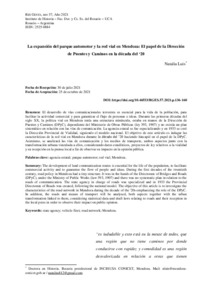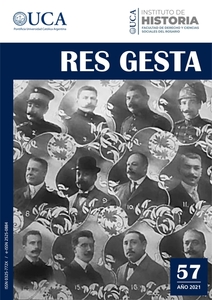Please use this identifier to cite or link to this item:
https://repositorio.uca.edu.ar/handle/123456789/13196| Título: | La expansión del parque automotor y la red vial en Mendoza: El papel de la Dirección de Puentes y Caminos en la década del ‘20 | Autor: | Luis, Natalia | Palabras clave: | HISTORIA DE MENDOZA; VIAS DE COMUNICACION; AUTOMOVILES; PLANIFICACION VIAL; CAMINOS; HISTORIA SOCIAL; MEDIOS DE TRANSPORTE | Fecha de publicación: | 2021 | Editorial: | Universidad Católica Argentina. Facultad de Derecho y Ciencias Sociales del Rosario. Instituto de Historia | Cita: | Luis, N. La expansión del parque automotor y la red vial en Mendoza: El papel de la Dirección de Puentes y Caminos en la década del ‘20 [en línea]. Res Gesta. 2021, 57. doi: https://doi.org/10.46553/RGES.57.2021.p.136-160. Disponible en: https://repositorio.uca.edu.ar/handle/123456789/13196 | Resumen: | Resumen: El desarrollo de vías comunicacionales terrestres es esencial para la vida de la población, para
facilitar la actividad comercial y para garantizar el flujo de personas e ideas. Durante las primeras décadas del
siglo XX, la política vial en Mendoza tenía una estructura minúscula, estaba en manos de la Dirección de
Puentes y Caminos (DPyC), dependiente del Ministerio de Obras Públicas (ley 393, 1907) y no existía un plan
sistemático en relación con las vías de comunicación. La agencia estatal se fue especializando y en 1933 se creó
la Dirección Provincial de Vialidad, siguiendo el modelo nacional. El objetivo de este artículo es indagar las
características de la red vial en Mendoza durante la década del ‘20 haciendo hincapié en el papel de la DPyC.
Asimismo, se analizará las vías de comunicación y los medios de transporte, ambos aspectos junto con la
transformación urbana vinculada a ellos, considerando datos estadísticos, proyectos de ley relativos a la vialidad
y su recepción en la prensa local a fin de observar su impacto en la opinión pública. Summary: The development of land communication routes is essential for the life of the population, to facilitate commercial activity and to guarantee the flow of people and ideas. During the first decades of the twentieth century, road policy in Mendoza had a tiny structure. It was in the hands of the Directorate of Bridges and Roads (DPyC), under the Ministry of Public Works (law 393, 1907) and there was no systematic plan in relation to the roads of communication. The state agency in charge of roads was specialized and in 1933 the Provincial Directorate of Roads was created, following the national model. The objective of this article is to investigate the characteristics of the road network in Mendoza during the decade of the '20s emphasizing the role of the DPyC. In addition, the roads and means of transport will be analysed, both aspects together with the urban transformation linked to them, considering statistical data and draft laws relating to roads and their reception in the local press in order to observe their impact on public opinion. |
Cobertura Espacial: | Mendoza (Argentina : Provincia) | Cobertura Temporal: | Siglo XX | URI: | https://repositorio.uca.edu.ar/handle/123456789/13196 | ISSN: | 2525-0884 (on line) 0325-772X (impreso) |
Disciplina: | HISTORIA | DOI: | https://doi.org/10.46553/RGES.57.2021.p.136-160 | Derechos: | Acceso abierto | Fuente: | Res Gesta No. 57, 2021 |
| Appears in Collections: | RG - 2021 nro. 57 |
Files in This Item:
| File | Description | Size | Format | |
|---|---|---|---|---|
| expansión-parque automotor-red.pdf | 1,52 MB | Adobe PDF |  View/Open | |
| cover_issue_391_es_AR.jpg | 176,12 kB | JPEG |  View/Open |
Page view(s)
89
checked on Apr 27, 2024
Download(s)
229
checked on Apr 27, 2024
Google ScholarTM
Check
Altmetric
Altmetric
This item is licensed under a Creative Commons License

